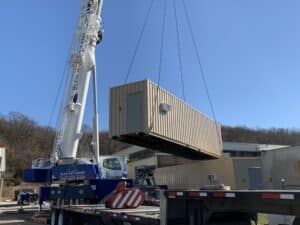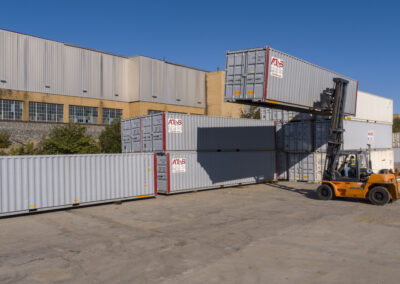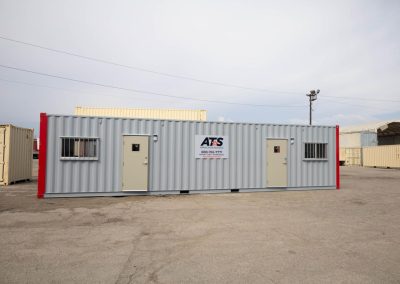In the ever-evolving landscape of construction, where efficiency and innovation are paramount, a game-changing solution has emerged – the use of shipping containers for on-site storage. This unconventional approach is rapidly gaining traction, as project managers seek to streamline operations, cut costs, and minimize their environmental impact. According to a recent industry report, over 60% of construction firms have adopted or are actively considering the use of shipping containers for storage, citing their numerous advantages.

Pros of Using Shipping Containers for Storage
Modular Nature and Flexibility
The inherent design of shipping containers allows for easy modification and repurposing. Whether you need a compact space for tools and equipment or a large area for holding construction materials, these containers can be adapted to meet any requirement. Their modular nature makes it possible to stack and connect multiple units, creating custom configurations that utilize vertical space efficiently.
Customization Options for Specific Needs
From installing shelving systems to climate controls, shipping containers can be outfitted with various amenities to cater to specific storage needs. For instance, heavy-duty shelving units can be installed to organize and store smaller items, while climate control systems can maintain optimal temperatures and humidity levels for sensitive materials like paints, electronics, or temperature-sensitive equipment. Insulation panels, ventilation systems, and lighting fixtures are other popular customization options that enhance the functionality and usability of these containers.
Cost-Effectiveness of Shipping Containers
Initial investment in a shipping container often proves more economical than constructing a warehouse or renting commercial storage space. The portability of containers eliminates the need for multiple storage solutions across various sites, reducing logistical headaches and significantly slashing transportation costs.
Long-Term Savings and Reduced Overhead
Durability is another cost-saving feature of shipping containers. Designed to withstand harsh environments, they offer excellent longevity and require minimal maintenance, ensuring that the initial investment pays dividends for years to come. Additionally, the option to rent shipping containers for short-term or temporary construction projects provides flexibility and cost-effectiveness, allowing companies to scale their storage needs as required without committing to a substantial upfront investment.
Construction and Material Strength
Shipping containers are built to endure. Made from high-grade steel, they resist corrosion, wind, and water, providing reliable protection against the elements and unauthorized access.
Enhanced Security Modifications
Additional security features such as lock boxes, reinforced bars, and alarm systems can be installed to further safeguard valuable construction assets from theft and vandalism.
Ease of Transportability Between Sites
One of the most significant benefits of shipping containers is their mobility. Equipped with handling points for lifting and moving, these containers can be easily relocated between project sites without the need for disassembly, offering a flexible and reusable storage option.
Minimal Setup Requirements
Unlike permanent structures, shipping containers require little to no foundation work, which means they can be deployed quickly and efficiently. This agility is crucial in meeting the tight deadlines typical of the construction industry.
Sustainability in Construction Storage
Choosing shipping containers as a storage solution not only serves practical needs but also promotes sustainability. By repurposing used containers, companies contribute to waste reduction and support eco-friendly practices within the industry.
Upcycling Containers for Reduced Waste
The upcycling of shipping containers is a testament to the construction industry’s capacity for innovative, green solutions. This practice significantly decreases the carbon footprint associated with manufacturing new storage units and demonstrates a commitment to environmental stewardship.
Compliance and Regulatory Benefits
Shipping containers are manufactured according to strict international regulations, ensuring high standards of quality and safety. Utilizing these pre-approved structures can simplify compliance with local building codes and insurance requirements.
Avoiding Compliance Issues with Portable Containers
The portability of shipping containers also helps circumvent zoning laws and land-use restrictions, making them an ideal choice for temporary installations on construction sites.
Weather Resistance
Shipping containers for construction storage are designed to withstand severe weather, making them suitable for use in a variety of climates, from the freezing conditions of the northern states to the intense heat of the southern plains.
Space and Accessibility Considerations
Although compact, shipping containers can be modified with roll-up doors, ramps, and other features to enhance accessibility and maximize usable space for storing construction materials and equipment.
Maximizing Project Efficiency with Shipping Containers
Shipping containers offer a myriad of benefits that can significantly enhance the efficiency and effectiveness of construction projects. Their durability, flexibility, and cost-efficiency make them an exemplary choice for on-site storage. By choosing to utilize shipping containers, project managers can not only optimize their operations but also contribute to a more sustainable and innovative construction landscape.


